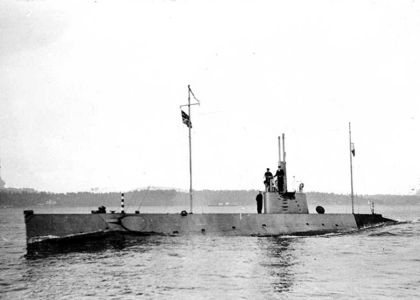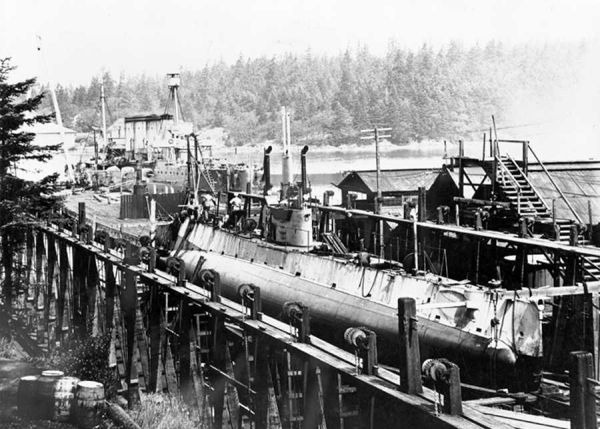Timeline: 1910-1919
Submarines CC1 and CC2
|
1910-1919
|
|||||||||||||||||
|
|||||||||||||||||
On the 5th of August 1914, two submarines originally intended for the Chilean Government were purchased by the BC Government from a shipyard in Seattle Washington.
The trick was to get them out of US territorial waters before they could be intercepted, as their sale to Canada violated US neutrality. So it was that the two boats 'sneaked out' of the harbour and into Canadian territorial waters to be inspected and finally purchased.
The Senior Naval Officer at Esquimalt had originally intended to call the submarines PATERSON and MCBRIDE after the builder and BC Premier respectively. Approval for this was not received, and an Australian precedent was followed. Two E-class submarines commissioned into the RAN from the RN were known as 'AE 1' and 'AE 2'. Thus, as the two submarines were roughly comparable to the RN C-class, they were named 'CC 1 (ex-Iquique of Chile and ex-Paterson) and CC 2 (ex-Antofagasta of Chile and ex-McBride).'

CC2 enroute to Esquimalt from Seattle.
These were small submarines of a type well adapted to operating in coastal waters. The approaches to Victoria and Vancouver through the Strait of Juan de Fuca and the islands were admirably suited to defence by means of submarines, simply because a ship in these waters would have a lot less room to manoeuver and would more than likely be following a more predictable course.
The surface displacement of the submarines was 313 tons surfaced and 412 tons submerged, and had a beam of 15'. CC 1 was 144' long and had 5 torpedo tubes, with an armament of 5 torpedoes. CC 2 was 152 feet long and had 3 torpedo tubes with an armament of 6 torpedoes. Both had one of their torpedo tubes mounted in the stern, and neither carried any gun armament. Their design speed was 13 knots surfaced and just over 10 knots submerged, though on 2 Nov 1914, CC1 achieved a speed of 15.1 knots over the measured mile. However, it would be the engines of CC 2 which would prove most reliable.
On the 21st of June 1917, they left Esquimalt for Halifax, and along with HMS SHEARWATER, became the first ships wearing the White Ensign to use the Panama Canal.
By the time they reached Halifax, their engines needed to be replaced, and their orders to refuel and proceed across the Atlantic to the Mediterranean had to be cancelled. Both were paid off to disposal and sold for scrap in 1920.

Submarine CC1 in the Esquimalt Slips
